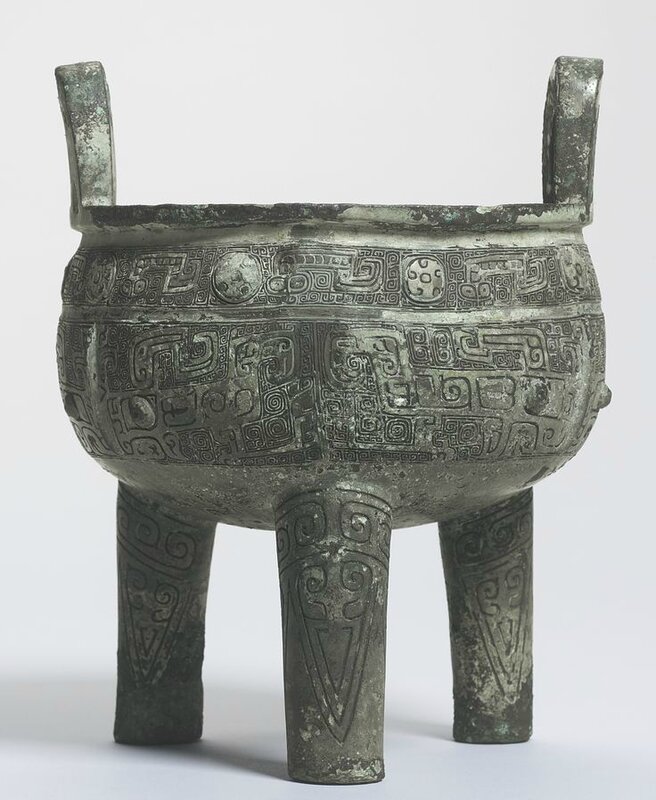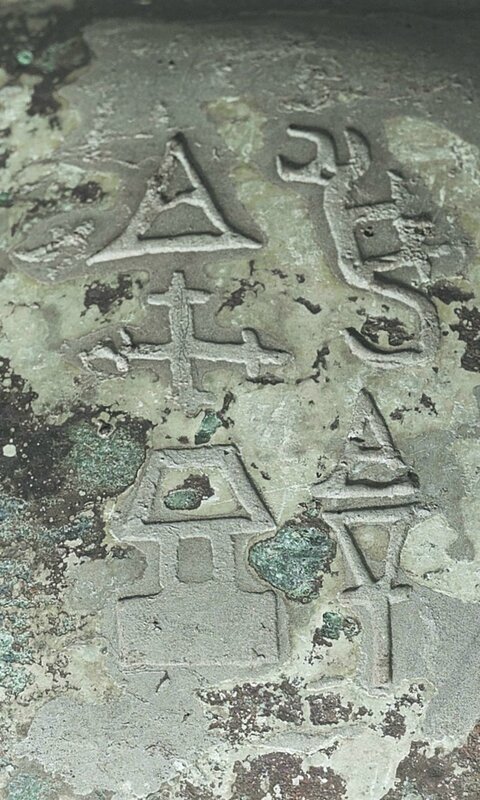The Quan Zu Xin Zu Gui Ding: An important inscribed bronze tripod, Shang dynasty, 13th-11th century BC
The Quan Zu Xin Zu Gui Ding: An important inscribed bronze tripod, Shang dynasty, 13th-11th century BC. Estimate 450,000 — 650,000 USD. Photo Sotheby's.
the deep round body supported on three cylindrical legs, the lipped rim raised with two upright large loop handles, a band below the rim filled with six serpents interspersed with whorl-roundels in relief, the central body with three large taotie motifs, with bulging eyes, intersected by flanges, all against a fine leiwen ground, the legs with scrolls and cicada blades in intaglio pattern, the interior cast on the side with a six-character inscription, the bronze covered with an attractive olive patina with areas of malachite encrustation. Height 10 1/4 in., 26 cm
Provenance: David A. Berg Collection.
Christie's New York, 21st September 2000, lot 160.
Sotheby's London, 19th June 2002, lot 73.
Private Asian Collection.
Literature: Wang Chen, Sequel of the Surviving Writings of the Shang dynasty, 1935, vol. 1, p. 21, fig. 9.
Luo Zhenyu, Surviving Writings from the Xia, Shang Zhou Dynasties, 1937, vol. 3, p. 1, fig. 3.
Yan Yiping, Corpus of Bronze Inscriptions, Taipei, 1983, no. 0753.
Institute of Archaeology, CASS, Compendium of Shang and Zhou Bronze Inscriptions, Beijing, 1984-94, no. 02113.
Wang Xiantang, A Record of Bronze and Stone Inscriptions in Chinese History, Qingdao, 2004, no. 2011-2.
Wang Tao and Liu Yu, A Selection of Early Chinese Bronzes with Inscriptions from Sotheby’s and Christie’s Sales, Shanghai, 2007, no. 60.
Wu Zhenfeng, Compendium of Inscriptions and Images of Bronzes from Shang and Zhou Dynasties, Shanghai, 2012, no. 01499.
Notes: The inscription on this bronze ding reads: QUAN ZU XIN ZU GUI XIANG, and is translated as 'Ancestor Xin and Ancestor Gui of Quan are sacrificed. X' The majority of Shang bronzes bear short inscriptions (ancestral names, personal names, or clan emblems). This ding vessel is of an impressive size and has a six-character inscription. The maker's name Quan (pictograph of a dog) here is also found in contemporary texts unearthed from Yinxu - the late capital of the Shang dynasty, and, apparently, was an important minister, likely a royal prince to the Shang king. On one of the large bronze tripods, a Shu Si Zi Ding, excavated at Anyang in 1959 (Kaoguxuebao 1960, no. 1, pls. 2) the inscription records the king awarding his princes with cowrie-shells for making ritual bronzes; and the recipients were Quan (dog) and Yu (fish).
According to a number of oracle bone inscriptions, Lord Quan led several royal clans into battle with the Zhou people (Heji: 6812 front); other sources record that Lord Quan made human sacrifices of the Qiang tribe men (Tunnan: 2493). There are more than twenty ritual bronzes bearing the name Quan, all dating from the Late Shang dynasty to the early Western Zhou period. On some of the Shang bronzes, Quan is associated with the official title ‘Ya’ as Ya Quan.
The style of the calligraphy here is well executed and with a strong pictographical element.
Sotheby's. Inscriptions: History as Art New York, 17 mars 2015, 01:30 PM

/https%3A%2F%2Fprofilepics.canalblog.com%2Fprofilepics%2F1%2F0%2F100183.jpg)
/https%3A%2F%2Fstorage.canalblog.com%2F03%2F02%2F119589%2F96711876_o.jpg)
/https%3A%2F%2Fstorage.canalblog.com%2F11%2F31%2F119589%2F94773502_o.jpg)
/https%3A%2F%2Fstorage.canalblog.com%2F20%2F83%2F119589%2F94772815_o.jpg)
/https%3A%2F%2Fstorage.canalblog.com%2F26%2F72%2F119589%2F75604929_o.jpg)
/https%3A%2F%2Fstorage.canalblog.com%2F59%2F60%2F119589%2F26458628_o.jpg)





/image%2F1371349%2F20240310%2Fob_a0939a_431263103-1627016698068343-29504461965.jpg)
/image%2F1371349%2F20240310%2Fob_c0e13b_431753965-1629270041176342-17091014609.jpg)
/http%3A%2F%2Fstorage.canalblog.com%2F79%2F20%2F119589%2F129837997_o.jpg)
/http%3A%2F%2Fstorage.canalblog.com%2F62%2F90%2F119589%2F129832900_o.jpg)